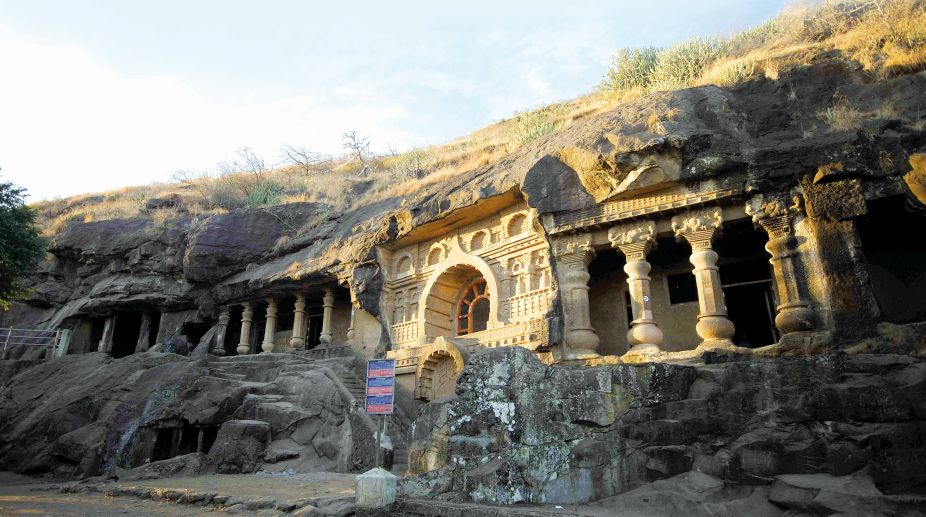Security personnel on election duty kills himself in Chhattisgarh
The incident, which occurred amidst the fervor of democratic engagement, has deeply saddened the community and sparked immediate inquiries by law enforcement.
From reserve forests to ancient pilgrimage sites, Madhya Pradesh offers delightful rewards to all tourists.

Pandava Caves
Being city people, we needed a break from the bustle and ventured to a place, which is far from the madding crowd. For that, we chose Madhya Pradesh — the largest state before the creation of Chhattisgarh and with the highest forest cover — during the merry season of colourful spring.
Our journey began from Kanha reserve forest and stationed in Safari Lodge overlooking the river Mukki, the first afternoon was charming with a jungle trail along the banks of the river. The rocks, trees and the peace stole our hearts at the first encounter.
The following day started with a safari ride in the morning followed by another session in the afternoon. We saw hordes of spotted deer, sambar, and waterbucks with long tree shaped horns, known as Barsinga, which is unique to Kanha.
Advertisement

Unfortunately, we did not spot a tiger, which is the sole expectation of visitors in Kanha .The silence, music of birds, and the occasional shrill calls of animals at night soothed our hearts.
Our next visit was to Panchmarhi, the only hill station in the state. The huge expanse of open spaces, clean atmosphere, and trees provided much needed relief to the eye and soul.
Panchmarhi is now a military training centre and the rehearsals of Army bands permeate the sky from dawn till dusk. There are the Pandava caves — important to Buddhist pilgrims —, which were according to mythological sources, the hiding place of the Pandavas during their exile in the forest.

The Bee Falls, probably deriving its name from the beehives of the forest — a bowl shaped deep and huge hilly gorge — or Handikho Reechgarh caves, which are huge caves believed to be the home to wild animals, were also picturesque locations we visited. The sunset spot in Dhoopgarh offered a panoramic view all around and was full of magical charm.
The Marble Rocks in Bhedaghat near Jabalpur city on the Narmada River with the unforgettable Narmada Falls and particularly the boat cruise on the river through the multicoloured rocks are once-in-a-lifetime experiences.
The next forest destination was Bandhavgarh Reserve Forest, which originally belonged to the Maharaja of Rewa estate. The rare white tiger was spotted there first by the King during one of his routine games in the forest as a pastime.

In both Kanha and Bandhavgarh, we spotted many peacocks and other species of birds, most of which were unknown to us, including a pair of lovely owls in a tree hole. The forest is also populated with huge trees, which were mostly shaal, mahua, tendu and other species.
The most remarkable part of our morning safari was the tiger Mangu, which was a full grown Royal Bengal Tiger treading with majestic strides, completely ignorant to our presence walking beside our jeep, sometimes so close, that we could reach out and touch it.
It finally disappeared slowly into the dense forest, after crossing the jungle path. The magnificent beauty of the big cat was a reminder of Jim Corbett’s anecdotes of Kumaon’s man-eaters.

Amarkantak, the holy pilgrimage centre was our last stop. The River Narmada is as holy to the people of Central and Western India, as the Ganges is to the people of Northern and Eastern India. Narmada originates from a pool of water or kund, created by a subterranean non-glacial source.
In fact, unlike the mighty Himalayan rivers, these Central and Southern Indian rivers are all from non- glacial sources. The Narmada meanders through the vast planes of Central India and enters Gujarat where it finally flows into the Arabian Sea.
There is a Narmada Mata Temple where she is regularly worshipped very much like Ganga Mata. Amarkantak is also known as the birth place of the River Shone, known as Shonmuda, which also has a big temple. The River Narmada takes a giant leap down into Kapildhara or Doodh Falls where a Kapil Muni Temple exists.

Pilgrimage apart, Amarkantak is a place of pristine serenity and natural beauty, which makes it a much sought-after tourist spot. En route we came across agricultural fields full of crops, especially mustard plants bedecked with fresh yellow blossoms at some spots.
On completing our invigorating and inspiring trip spread over the course of twelve days, it was time for our journey back home, just as birds fly back to their nests at the end of the day.
Advertisement